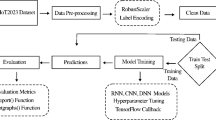Abstract
In the recent years, security issues have been increasing with the rapid development of artificial intelligence technology. Malware delivery is important for exploitation of the target and must be delivered covertly and evasively. Existing work has given possibility of embedding malware into a neural network model with limited impact on the performance. With the wide application of artificial intelligence, utilizing neural networks for attacks becomes emerging trend. In this paper, we propose attack methods for target exploitation using neural networks models. This work can provide a reference scenario for the defense on neural network assisted attacks.
Access this chapter
Tax calculation will be finalised at checkout
Purchases are for personal use only
Similar content being viewed by others
References
Dhilung Kirat JJ, Stoecklin MP (2018) Deeplocker: concealing targeted attacks with AI locksmithing. Blackhat USA, pp 1–29
Wang Z, Liu C, Cui X, Yin J, Liu J, Wu D, Liu Q (2022) DeepC2: AI-powered covert command and control on OSNs. International conference on information and communications security. Springer, Cham, pp 394–414
Chandu NS, Subramanian N (2022) Countering steganographic security with CNN. In: Proceedings of the 2022 10th international symposium on digital forensics and security (ISDFS). IEEE, pp 1–6
Chanchal M, Malathi P, Kumar G (2020) A comprehensive survey on neural network based image data hiding scheme. In: Proceedings of the 2020 fourth international conference on I-SMAC (IoT in social, mobile, analytics and cloud). IEEE, pp 1245–1249
Liu T, Liu Z, Liu Q, Wen W, Xu W, Li M (2020) Stegonet: turn deep neural network into a stegomalware. In: Annual computer security applications conference, pp 928–938
Ramesh R, Chaudhari P (2021) Model zoo: a growing, brain that learns continually. arXiv preprint arXiv:2106.03027
Akshita P, Amritha PP (2022) Enhanced security layer for hardening image steganography. In: Congress on intelligent systems: proceedings of CIS 2021, vol 2. Springer, Singapore, pp 753–765
Sherly AP, Amritha PP (2010) A compressed video steganography using TPVD. Int J Database Manag Syst 2(3):67–80
Volkhonskiy D, Nazarov I, Burnaev E (2019) Steganographic generative adversarial networks. In: Twelfth international conference on machine vision, ICMV 2019, vol 11433. SPIE, pp 991–1005
Zhang Y, Zhang W, Chen K, Liu J, Liu Y, Yu N (2018) Adversarial examples against deep neural network based steganalysis. In: Proceedings of the 6th ACM workshop on information hiding and multimedia security. ACM, pp 67–72
Seymour J, Tully P (2016) Weaponizing data science for social engineering: automated e2e spear phishing on twitter. Black Hat USA 37:1–39
Pantic N, Husain MI (2015) Covert botnet command and control using twitter. In: Proceedings of the 31st annual computer security applications conference, pp 171–180
Karapapas C, Pittaras I, Fotiou N, Polyzos GC (2020) Ransomware as a service using smart contracts and IPFS. In: IEEE international conference on blockchain and cryptocurrency (ICBC). IEEE, pp 1–5
Hitaj B, Gasti P, Ateniese G, Perez-Cruz FP, Passgan S (2019) A deep learning approach for password guessing. In: Proceedings of the international conference on applied cryptography and network security, pp 217–237
Rigaki M, Garcia S (2018) Bringing a GAN to a knife-fight: Adapting malware communication to avoid detection. In: IEEE security and privacy workshops, pp 70–75
Hu W, Tan Y (2022) Generating adversarial malware examples for black-box attacks based on GAN. International conference on data mining and big data. Springer, Singapore, pp 409–423
Wang J, Liu Q, Wu D, Dong Y, Cui X (2021) Crafting adversarial example to bypass flow- and ML-based botnet detector via RL. In: Proceedings of the 24th international symposium on research in attacks, intrusions and defenses. ACM, pp 193–204
Wang Z, Liu C, Cui X, Yin J, Wang X (2022) EvilModel 20: bringing neural network models into malware attacks. Comput Secur 120:102807
Author information
Authors and Affiliations
Corresponding author
Editor information
Editors and Affiliations
Rights and permissions
Copyright information
© 2024 The Author(s), under exclusive license to Springer Nature Singapore Pte Ltd.
About this paper
Cite this paper
Gurram, V.R., Amritha, P.P., Sethumadhavan, M. (2024). Exploiting Neural Network Model for Hiding and Triggering Malware. In: Iglesias, A., Shin, J., Patel, B., Joshi, A. (eds) Proceedings of World Conference on Information Systems for Business Management. ISBM 2023. Lecture Notes in Networks and Systems, vol 833. Springer, Singapore. https://doi.org/10.1007/978-981-99-8346-9_18
Download citation
DOI: https://doi.org/10.1007/978-981-99-8346-9_18
Published:
Publisher Name: Springer, Singapore
Print ISBN: 978-981-99-8345-2
Online ISBN: 978-981-99-8346-9
eBook Packages: Intelligent Technologies and RoboticsIntelligent Technologies and Robotics (R0)




